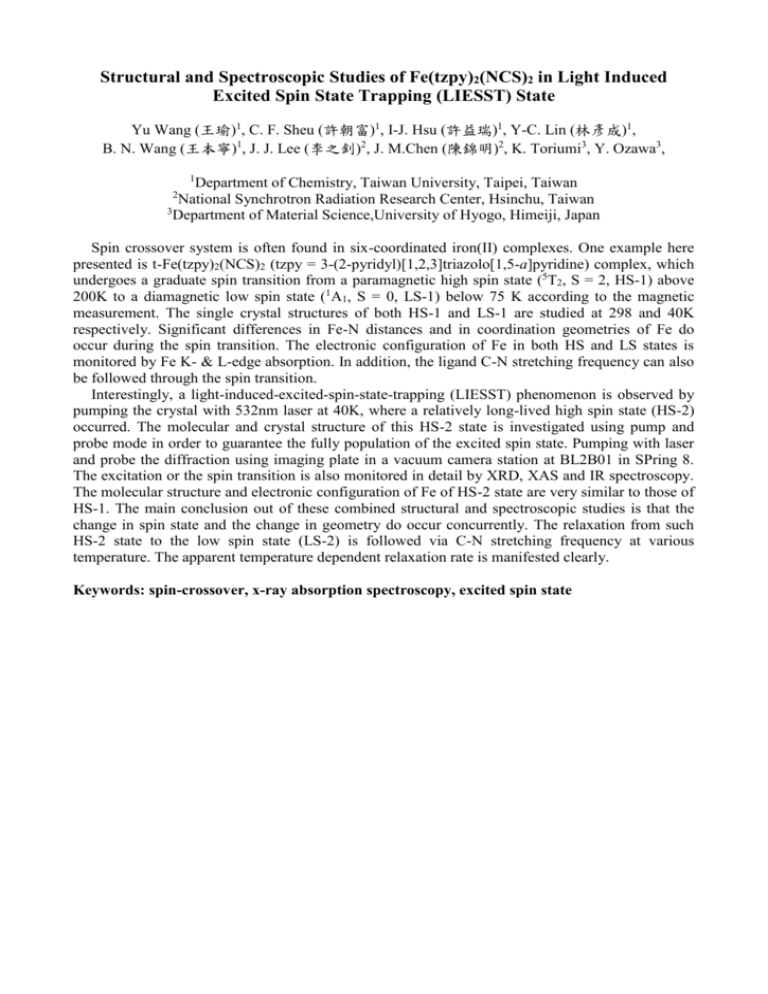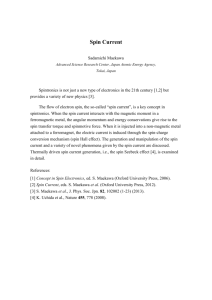Structural and Spectroscopic Studies of Fe(tzpy)2(NCS)2 in Light
advertisement

Structural and Spectroscopic Studies of Fe(tzpy)2(NCS)2 in Light Induced Excited Spin State Trapping (LIESST) State Yu Wang (王瑜)1, C. F. Sheu (許朝富)1, I-J. Hsu (許益瑞)1, Y-C. Lin (林彥成)1, B. N. Wang (王本寧)1, J. J. Lee (李之釗)2, J. M.Chen (陳錦明)2, K. Toriumi3, Y. Ozawa3, 1 Department of Chemistry, Taiwan University, Taipei, Taiwan National Synchrotron Radiation Research Center, Hsinchu, Taiwan 3 Department of Material Science,University of Hyogo, Himeiji, Japan 2 Spin crossover system is often found in six-coordinated iron(II) complexes. One example here presented is t-Fe(tzpy)2(NCS)2 (tzpy = 3-(2-pyridyl)[1,2,3]triazolo[1,5-a]pyridine) complex, which undergoes a graduate spin transition from a paramagnetic high spin state (5T2, S = 2, HS-1) above 200K to a diamagnetic low spin state (1A1, S = 0, LS-1) below 75 K according to the magnetic measurement. The single crystal structures of both HS-1 and LS-1 are studied at 298 and 40K respectively. Significant differences in Fe-N distances and in coordination geometries of Fe do occur during the spin transition. The electronic configuration of Fe in both HS and LS states is monitored by Fe K- & L-edge absorption. In addition, the ligand C-N stretching frequency can also be followed through the spin transition. Interestingly, a light-induced-excited-spin-state-trapping (LIESST) phenomenon is observed by pumping the crystal with 532nm laser at 40K, where a relatively long-lived high spin state (HS-2) occurred. The molecular and crystal structure of this HS-2 state is investigated using pump and probe mode in order to guarantee the fully population of the excited spin state. Pumping with laser and probe the diffraction using imaging plate in a vacuum camera station at BL2B01 in SPring 8. The excitation or the spin transition is also monitored in detail by XRD, XAS and IR spectroscopy. The molecular structure and electronic configuration of Fe of HS-2 state are very similar to those of HS-1. The main conclusion out of these combined structural and spectroscopic studies is that the change in spin state and the change in geometry do occur concurrently. The relaxation from such HS-2 state to the low spin state (LS-2) is followed via C-N stretching frequency at various temperature. The apparent temperature dependent relaxation rate is manifested clearly. Keywords: spin-crossover, x-ray absorption spectroscopy, excited spin state








